Solutions for Pests & Insects
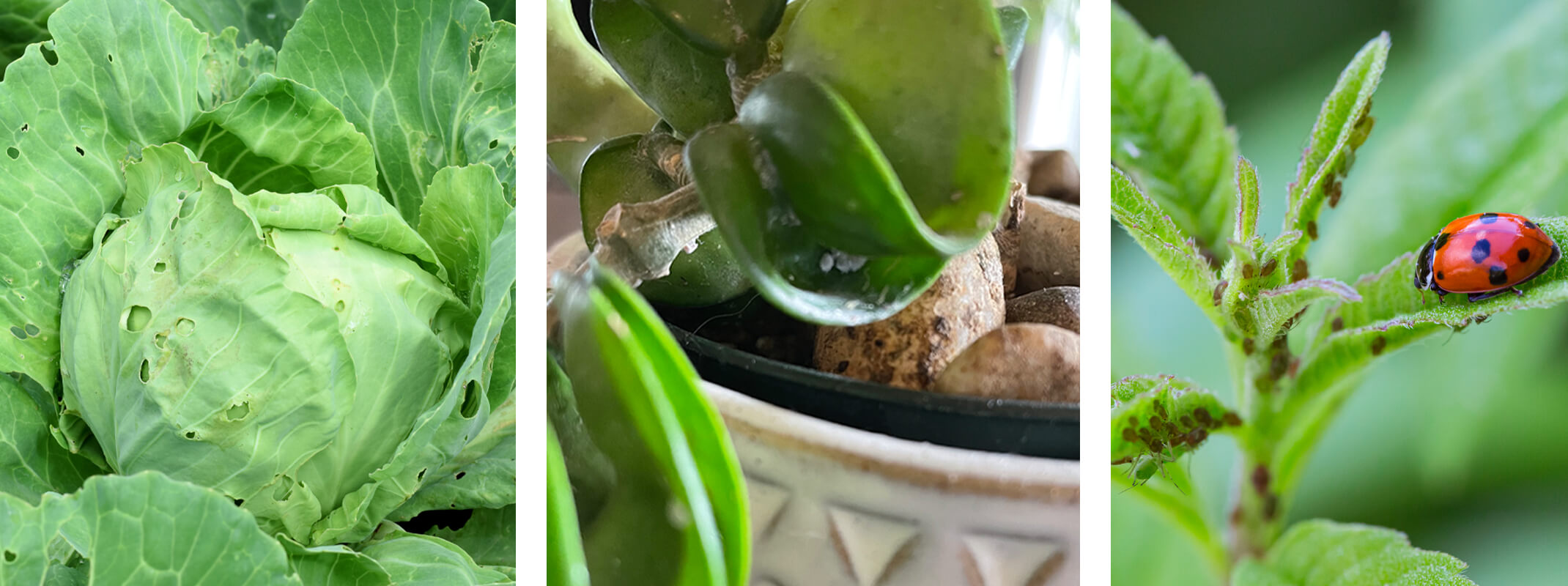 Watch Out For These Notorious Plant Pests
Watch Out For These Notorious Plant Pests
 Aphids
Aphids
What They Look Like
These tiny little pear-shaped bugs have long legs and antennae. They can be green, yellow, brown, red, or black, depending on what kind of plants they like to feed on. The most telltale sign of an aphid infestation is sticky droplets all over your plants. This substance is known as honeydew, which is a surprisingly pleasant name for what is essentially bug poop.
What’s The Damage?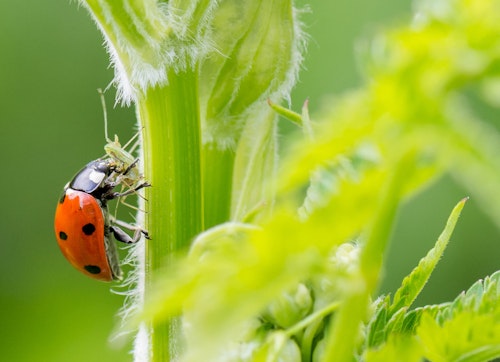
Aphids feed by sucking the moisture out of plants, which causes yellow leaves and stunts the growth of new shoots. While a small aphid outbreak isn’t likely to do large-scale damage, this is a plant pest with strength in numbers, so large colonies can do considerable damage. Their sticky honeydew rapidly builds up, which leads to all sorts of problems like mold growth or the arrival of ants who are attracted to the sugary substance. Some (but not all) aphids also inject a toxin into plants, which can distort growth and damage leaves even further.
How to Get Them Out
While it’s unlikely that aphids alone will end up taking down an entire plant, their damage is unsightly, and their waste can lead to a host of other problems. Use a non-chemical treatment to get rid of them—chemical pesticides can pose a major threat to beneficial bugs that help keep pest populations under control.
- Bug Boxes: Those beneficial bugs we just mentioned? You can buy them here at SummerWinds Nursery! Ladybugs are the most common commercially available predatory insect, and they come stored in a chilled container that coaxes them into hibernation. Once you bring them home and allow their temperature to rise, they’ll soon wake up with a raging appetite. Release them into your garden, and they will happily feed on aphids and other pesky insects.
- Ant Management: Since honeydew attracts ants, you may end up with double the pest problems. Furthermore, ants also protect aphids from their natural enemies, so when these bad bugs join forces, they can be harder to beat. Use Diatomaceous Earth.
- Natural Pesticides: Several forms of chemical-free pesticides work wonders for killing the bad bugs while sparing our precious pollinators and predatory bugs. Bonide Insecticidal Soap spray, Bonide Horticultural Oil, and Bonide Neem Oil solution can all be safely used outside without posing a threat to beneficial wildlife.
Scales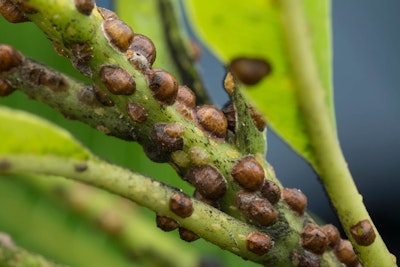
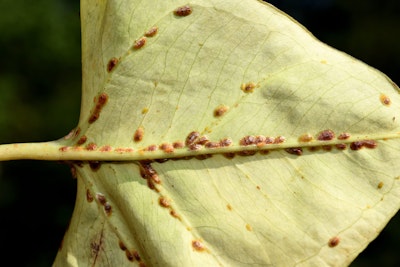
What They Look Like
These strange insects are masters of disguise. They definitely don’t look like your typical creepy-crawlies, but once you know what to look for, they’re much easier to spot.
- Armored Scales: Scale insects with armor look like tiny, hard bumps that don’t move. The actual insect body is hiding underneath the shell-like coating they produce, and if you pull their hard coating off, the bug will still remain on the plant. As the insect grows, the armor will grow with them, often with visible concentric circles, slight color variance, and a small tip that sticks out from the center. They’re under ⅛ inch in diameter and don’t produce honeydew.
- Soft Scales: These scales are a bit bigger, measuring around ¼ inch long, with a smooth surface that’s cottony or waxy in appearance. They’re a bit rounder than armored scales, and they produce lots of sticky honeydew.
What’s The Damage?
The severity of the damage is dependent on how bad the scale infestation is. You can expect to see some yellowing leaves, premature leaf drop, or possibly some blemishes on fruit, leaves, and twigs. Worst case scenario, you’ll see some twig dieback and will have to prune out all the dead bits. Honeydew droppings are the most significant problem you’ll encounter with scale insects because it attracts ants and can develop black mold. Soft scales aren’t likely to kill an entire tree or shrub, but they can weaken your plants and slow down growth, so it’s a good idea to get rid of them promptly.
How to Get Them Out
- Dormant Season: Late winter, when your plants and trees are dormant, is a great time to kill scale insects that may be overwintering on your deciduous woody plants. Spray a generous amount of Bonide Horticultural Oil all over the bark of terminal shoots.
- Foliage Spray: You can also use Bonide Horticultural Oil in spring or summer on deciduous plants when most scales are in their nymph stage. Spray any spots along the branches and shoots where you can see scale insects, and spray the undersides of the leaves, too—it’s one of the most common hiding spots for plant pests!
Thrips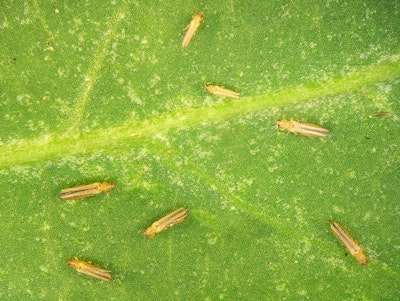
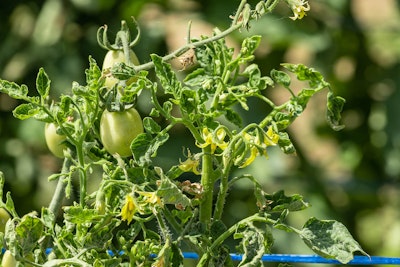
What They Look Like
Thrips are skinny insects with fringed wings and are usually a yellowish-brown color. They often leave behind a trail of tiny, black droppings that are shiny like varnish.
What’s The Damage?
It’s super easy to spot thrip damage if you know what to look for. They puncture plant leaves and suck out the contents, leading to discoloration, distorted leaves with a paper-like texture, tiny white spots (stippling), and premature leaf drop. While they aren’t likely to kill a tree or shrub, they can really injure vegetable plants and ornamentals if left untreated.
How to Get Them Out
A contact insecticide, like horticultural oil, or a Spinosad formula, like Captain Jack’s Deadbug Brew, will kick those thrips to the curb.
Whiteflies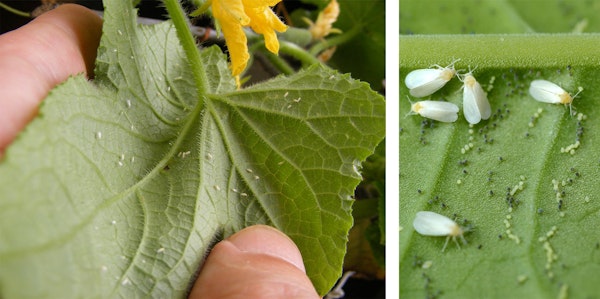
What They Look Like
These tiny little winged insects aren’t technically flies—they’re actually close relatives of the aphid. They got their name from the white, mealy wax that covers the adult’s wings and body.
What’s The Damage?
Whiteflies have needle-like mouthparts like a mosquito to pierce plant tissue and suck out the sap. If you’ve got a big swarm of whiteflies eating your plant, the leaves will turn yellow, curl up, dry out, and fall off. Whiteflies also excrete honeydew, so sticky residue and evidence of black mold are common red flags for these pests.
How to Get Them Out
It’s tricky to kill whiteflies because they’ll only kick the bucket if you directly spray them with natural insecticides. It certainly isn’t impossible, though—just perform a few repeat applications until their numbers dwindle. Bonide's Insecticidal Soap, Neem Oil, or Horticultural Oils will all work fine. Sticky traps are also a great solution.
Mealybugs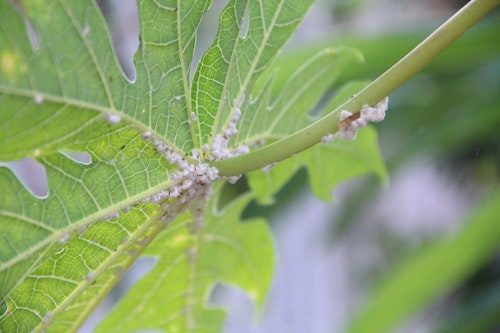
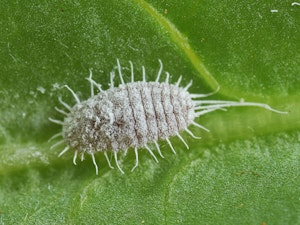
What They Look Like
If you’re creeped out by bugs, you won’t be pleased by the sight of a swarm of mealybugs. These little grey bugs have waxy, hair-like filaments that stick out all over their bodies. They don’t have wings, move slowly, and huddle together in groups, coating themselves in whitish mealy or cotton-like wax. Yuck!
What’s The Damage?
Like many common plant pests, mealybugs suck out the sap from plants and leave a trail of sticky honeydew behind them. They reduce the growth and vigor of plants and can negatively impact the quality of your fruits and veggies. Be on high alert for mealybugs in greenhouses and indoor plants because mealybugs are happiest in environments with consistently mild temperatures.
How to Get Them Out
- Isopropyl Alcohol Spot Treatments: A 70% alcohol solution is a super effective way to kill mealybugs, but you need to be careful when applying it as the treatment can dehydrate plant leaves. For indoor plants, it’s easy to dip a cotton swab in alcohol and apply it to the bugs directly. If you’ve got a major infestation, you can spray alcohol directly on the plant, but you should rinse it off with water an hour or two later to avoid dehydration. Repeat the application once per week until the mealybugs are gone.
- Natural insecticides: Insecticidal soaps, neem oil, and horticultural sprays work if applied directly onto the mealybugs. Repeat every 4–5 days until the problem is resolved.
Snails & Slugs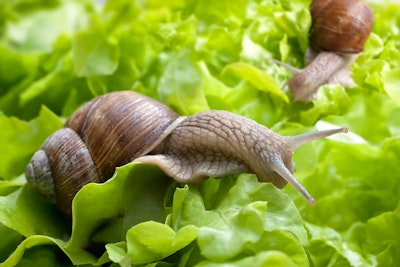
What They Look Like
You’re probably familiar with slugs and snails—the peculiar, slow-moving mollusks that emerge from the garden at night, leaving behind trails of slime. But what you might not know is that they’re one of the most destructive plant pests out there! They may look harmless and maybe even kind of cute, but snails and slugs have huge appetites and will chow down on your plants like it’s an all-you-can-eat salad bar.
What’s The Damage?
Big, gaping holes in leaves, flowers, and fruit are bound to appear in your garden if hungry slugs and snails start to feast.
How to Get Them Out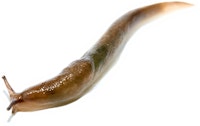
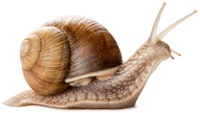
The best way to keep slugs and snails away is through a combined approach with prevention, trapping, barriers, pesticides, and simply hand-picking them off the plant. Here are a few methods and formulas that are worth trying out:
- Diatomaceous Earth: This abrasive substance is made from old fossils, and if you sprinkle it onto the soil, it will cut into the delicate bodies of slugs. This creates an effective barrier for keeping them away.
- Iron Phosphate Formulas: Products like SluggoPlus and Snail Bait are pelletized formulas that slugs and snails will eat up, effectively killing them. It lasts for four weeks at a time and poses no threat to pets or other wildlife.
- Iron Phosphate Formulas: Products like SluggoPlus and Snail Bait are pelletized formulas that slugs and snails will eat up, effectively killing them. It lasts for four weeks at a time and poses no threat to pets or other wildlife.
- Beer Traps: Hide little saucers of beer throughout the garden in shaded areas under leaf canopies. This will lure in the slugs and snails so you can easily toss them in the trash.
- Eliminate Pooling Moisture: If moisture is pooling in your garden, it can attract slugs and snails. Ensuring that your soil has good drainage and isn’t compacted will prevent this from happening.
Earwigs
What They Look Like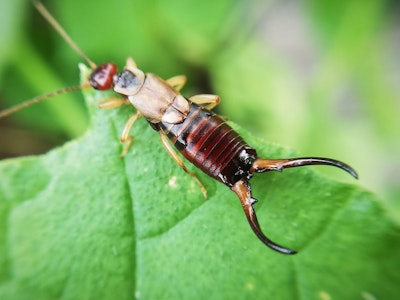
We won’t lie; spotting an earwig often results in shrieks of horror. The large pincers that stick out from their head are pretty startling. Don’t worry; they aren’t likely to bite unless you pick them up by hand and spook them. They don’t have any venom, so if you do get pinched, it can be easily cleaned and treated.
What’s The Damage?
If you’re seeing signs of plant damage and bite marks but can’t see any pests lingering around, earwigs might be to blame. They work at night, and during the day, they seek out dark, moist places to hide, such as dense weeds, low-growing vines, or underneath loose clods of soil or lawn debris. To confirm that earwigs are the culprits of your garden damage, go outside at night with a flashlight and scan the area.
How to Get Them Out
Sluggo Plus is a formula that combines iron phosphate with Spinosad, and it’s great for killing earwigs and many other common plant pests.
Citrus Leafminer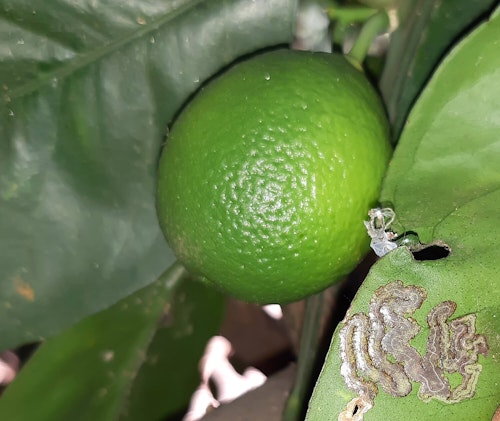
What They Look Like
The larvae of the citrus leafminer are the ones to watch out for. They can do major damage to the foliage of citrus trees, like lemon, lime, orange, grapefruit, and other closely related plants like kumquats and calamondin. You aren’t likely to see them directly because they crawl inside the leaves and munch their way through, creating squiggly white tunnels all over the leaves.
What’s The Damage?
Mature leaves aren’t likely to get overrun with leafminers unless you have a major infestation. New growth is much more vulnerable to leafminers, and the squiggly white lines are a telltale sign. This damage also leads to curling, distorted leaves.
How to Get Them Out
Use a Spinosad formula, such as Bonide's Captain Jack's Orchard Spray, Captain Jack’s Deadbug Brew, to combat leafminers. Trim off all damaged leaves with sanitized shears.
The Solutions...For Organic Gardening
Bonide All Seasons Horticultural Spray Oil
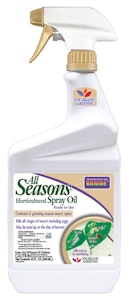

For organic gardening. A superior type of paraffinic oil that may be used as a growing season spray, dormant spray (no leaves) or delayed dormant (green tip) spray to control overwintering eggs of red spiders, scale insects, aphids, bud moths, leaf roller, red bug, codling moth, blister mites, galls, whitefly, mealy bugs and other insects and diseases. Highly recommended for use on fruit trees, shade trees, shrubs, ornamentals, roses, and vegetables. Safe and pleasant to use.
- Controls insects and diseases by suffocation
- Approved for organic gardening
- Dormant and growing season horticultural oil
- Formulated with paraffinic oil to smother insects on listed plants
- Kills insects and their overwintering eggs
Bonide Captain Jack's Deadbug Brew
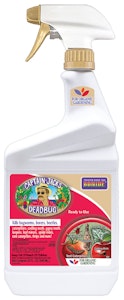

BONIDE Captain Jack's Deadbug Brew® is approved for organic gardening to control a wide range of listed insect pests. Use on listed vegetables, citrus, fruits flowers, and ornamentals. Contains Spinosad®.
- Kills insects on vegetables, berries, citrus, grapes, nuts and ornamentals
- Approved for organic gardening
- For listed vegetables, apples and citrus trees
- Kills bagworms, borers, beetles, caterpillars
- Also kills leaf miners, spider mites and thrips
Bonide Insecticidal Soap
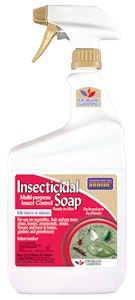

Potassium Salts of fatty acids from plants kills insects on contact. Ideal for houseplants, vegetables, flowers, & fruits. Suitable for organic gardening & may be used up to the day of harvest. This product is conveniently ready to use when it arrives at your home. The spray nozzle makes this product easy to deploy.
- Organically controls insects on houseplants
- Approved for organic gardening
- Indoor/Outdoor use
- Kills insects in minutes
- For use in homes, gardens, and greenhouses
Bonide Captain Jack's™ Neem Oil
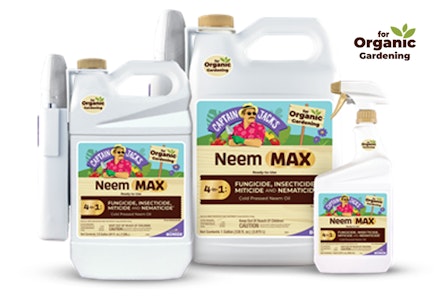

An all-purpose insecticide, miticide, and fungicide for organic gardening that is derived from the Neem seed, it can be used on roses, flowers, vegetables, herbs, spices, houseplants, trees, turf and shrubs. Kills all stages of insects including eggs, larvae, and adults.
- Controls insects, diseases and mites
- Approved for organic gardening
- Kills insect eggs, larvae and adults
- Controls black spot, powdery mildew, rust and more
- Kills mites, aphids, whiteflies and more
Bonide Diatomaceous Earth Dust
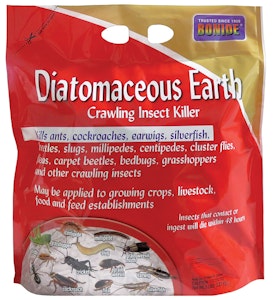

Bonide Diatomaceous Earth is used for insect control. It can be used both indoors and outdoors. Works within 48-hours by contact and ingestion. A natural option for killing crawling insects.
- Provides indoor/outdoor insect control by contact and ingestion
- Insects cannot become immune to its action
- Can be applied as a dust or slurry
- Insects succumb within 48 hours of contact
- Kills asian lady beetles, boxelder bugs, mites, crickets and more
Bonide Captain Jack's Orchard Spray
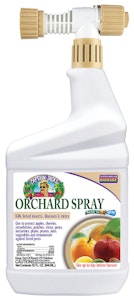

Controls a wide range of fungal diseases and insects on listed fruit, nuts, citrus, vegetables, ornamentals, houseplants, and lawns. Can be used up to the day before your harvest. This product is ready to be used once it arrives. Truly effective and all-purpose.
- Controls both insects and diseases on listed citrus, fruits and nuts
- Use up to day before harvest
- Contains sulfur and pyrethrin
- Insecticide, fungicide, & miticide
- Controls scab, powdery mildew, rust, blight, and other listed diseases
Monterey Sluggo Plus

Pellets for control of insects, slugs and snails
- For outdoor use around residential sites
- Kills earwigs, cutworm, sowbugs, pillbugs, crickets, ants (excluding Fire Ants, Harvester Ants, Pharaoh’s Ants and Carpenter Ants), slugs, and snails
- Contains Spinosad, derived from a naturally-occurring soil dwelling bacterium
- Easy-to-use pellet formulation
Monterey Sluggo
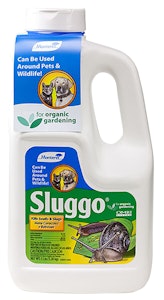
- Kills snails and slugs
- Can be used around pets and wildlife
- Uses iron phosphate which naturally occurs in soil
- Easy-to-use granular formulation
- Remains effective after rain or sprinkling
- May be used up to and including day of harvest

